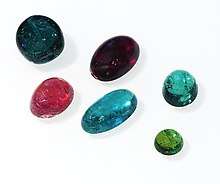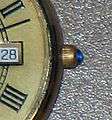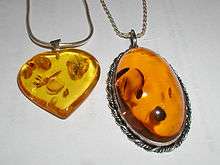Cabochon
A cabochon (/ˈkæbəˌʃɒn/, from Middle French caboche "head") is a gemstone which has been shaped and polished as opposed to faceted. The resulting form is usually a convex (rounded) obverse with a flat reverse.[1] Cabochon was the default method of preparing gemstones before gemstone cutting was developed.

Application
Cutting en cabochon (French: "in the manner of a cabochon") is usually applied to opaque gems, while faceting is usually applied to transparent stones. Hardness is also taken into account as softer gemstones with a hardness lower than 7 on the Mohs hardness scale are easily scratched, mainly by silicon dioxide in dust and grit. This would quickly make translucent gems unattractive—instead they are polished as cabochons, making the scratches less evident.
In the case of asteriated stones such as star sapphires and chatoyant stones such as cat's eye chrysoberyl, a domed cabochon cut is used to show the star or eye, which would not be visible in a faceted cut.
The usual shape for cutting cabochons is an ellipse. This is because the eye is less sensitive to small asymmetries in an ellipse, as opposed to a uniformly round shape, such as a circle, and because the elliptical shape, combined with the dome, is attractive. An exception is cabochons on some watches' crowns, which are round.
The procedure is to cut a slab of the rough rock with a slab saw, and next to stencil a shape from a template. The slab is then trimmed near the marked line using a diamond blade saw—called a trim saw. Diamond impregnated wheels or silicon carbide wheels can be used to grind the rough rock down. Most lapidary workshops and production facilities have moved away from silicon carbide to diamond grinding wheels or flat lap disks.
Once the piece is trimmed it can be "dopped" or completed by hand. "Dopping" is normally done by adhering the stone with hard wax onto a length of wooden dowel called a "dop stick". The piece is then ground to the template line, the back edges may be bevelled, and finally the top is sanded and polished to a uniform dome.
Gallery
 Moonstone cabochons in a jeweller's window
Moonstone cabochons in a jeweller's window

References
- Rock and gem (1st American ed.). DK Pub. ISBN 0-7566-0962-3.
External links
| Wikimedia Commons has media related to Cabochons. |
| Look up Cabochon in Wiktionary, the free dictionary. |